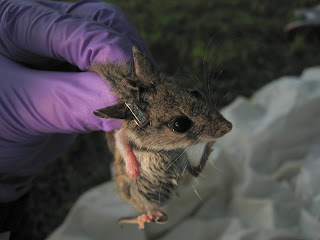Today is International Towel Day (http://en.wikipedia.org/wiki/Towel_Day), in honor of the life and works of Douglas Adams. Douglas Adams is probably my favorite author, I read something of his almost every year, if not more. Every time I read one of his books I find something new, and in many cases fall deeper in love with the stories, characters, the universe he created and the integrated commentary on science, art, and human nature. I could expound on some of my favorite bits (Bach’s music being the music life, the joys of flying between Arthur and Fenchurch, the “bistro-drive”) but that would digress a bit from what this blog is supposed to be about.
Adams had great interest in natural history, evolution, and biology in general. He was friends with Richard Dawkins and spent a year traveling around the world looking for severely endangered species with zoologist Mark Carwardine (my favorite book, Last Chance to See, was the result). The idea of “the fundamental interconnectedness of all things” that is integral to the Dirk Gently books has been quite an inspiration for me throughout my scientific career. As a community ecologist, I think it does a great job describing how I think about what I study.
“The term `holistic' refers to my conviction that what we are concerned with here is the fundamental interconnectedness of all things. I do not concern myself with such petty things as fingerprint powder, telltale pieces of pocket fluff and inane footprints. I see the solution to each problem as being detectable in the pattern and web of the whole. The connections between causes and effects are often much more subtle and complex than we with our rough and ready understanding of the physical world might naturally suppose.”
The main thing I take away from it is, what good is looking at each individual piece of the puzzle if you’re not thinking about the whole picture? It is best to learn about each piece, or species, as well as how they fit together, that’s when you’ll truly understand their role in the environment, how they interact with other, and what happens when a system is perturbed. That is the main goal of my research, trying to quantify the most important aspects of disease in a natural setting, what influences disease prevalence, and what causes differences between habitats, host communities, tick communities, and individuals within a population.
Some great coincidences from this morning’s work:
The animal with the most ticks (44 of them) ended up with ear tag number 542
The phrase “gusty winds may exist” was a good descriptor of the weather
Not quite a coincidence, but “Don’t Panic” is a good phrase to keep in mind while dealing with crazy spring weather!
Uses for a towel while doing field work:
- Dragging for ticks
- Wrap around head to protect from horrible biting gnats
- Wipe bug spray and other things off your glasses (did this one)
- Sit on it while checking animals for ticks
- Dry off with it after being rained on, because it seemed clean enough (did this one too)
Number 542: top with big tick on his nose, bottom showing ear tag.



No comments:
Post a Comment